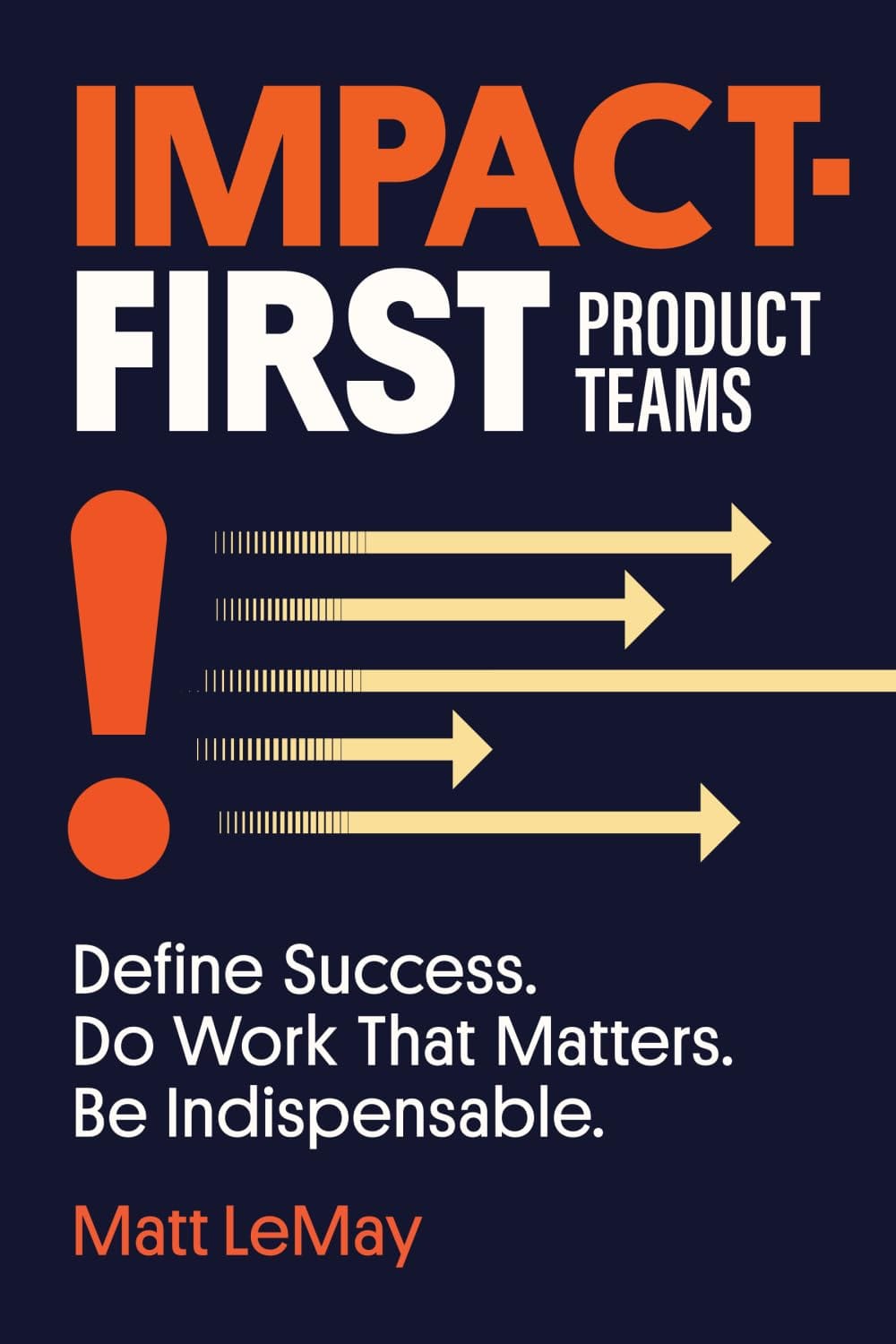Impact First Product Teams

Impact-First Product Teams: A Paradigm Shift for Business Relevance and Success
High-Level Overview: Key Arguments and Goals
- Critique of Traditional Product Management: Many product teams are disconnected from the business impact of their work, focusing on outputs (features) rather than outcomes (business results).
- The "Low-Impact Death Spiral": Teams can get caught delivering low-value features that complicate products without improving business metrics, making high-impact work harder.
- Irrelevance of Dogmatic "Best Practices": Adhering rigidly to generic "best practices" is ineffective if not tailored to the specific business context and its impact goals.
- Need for Commercial Savvy: Product teams must develop strong commercial awareness to understand how their work contributes to revenue, growth, and profitability.
- Impact-First Philosophy: Prioritize measurable business impact in all decisions, from goal setting to daily tasks.
- Strategic Alignment is Key: Team goals should be set "one step away" from company goals to ensure direct contribution to business success.
- Proactive Communication: Teams must engage in proactive conversations about impact, ask hard questions, and clearly articulate the value of their work.
- The Impact-First Product Cascade: A framework to connect day-to-day work to overarching business impact.
- Becoming Indispensable: By consistently delivering and demonstrating business impact, product teams become vital to the organization's success.
Overall Summary
Matt Lemay's "Impact-First Product Teams: Define Success. Do Work That Matters. Be Indispensable." addresses a critical challenge in modern product management: the pervasive disconnect between product team activities and tangible business impact. In a turbulent economic landscape, Lemay argues that simply "doing things the right way" is insufficient if it doesn't translate to business success. The book provides a practical guide for product teams to shift their focus from outputs to outcomes, emphasizing the need for commercial savvy, strategic alignment, and a relentless focus on measurable business results. Lemay introduces concepts like the "Low-Impact Death Spiral" to illustrate common pitfalls and offers the "Impact-First Product Cascade" as a framework to help teams connect their daily work directly to high-level business goals, ultimately enabling them to become indispensable to their organizations.
Introduction: The Imperative for Impact-Driven Product Management
Matt Lemay, an experienced product leader and author, argues that in today's demanding business environment, product teams can no longer afford to be disconnected from the business impact of their work. Traditional approaches, often focused on methodologies and feature delivery, are proving insufficient if they don't contribute to critical business metrics like revenue, growth, or profitability. The book "Impact-First Product Teams" emerges as a timely response, offering "clear-eyed and reality-tested guidance" for teams to navigate this landscape and demonstrate their value. The core problem identified is that many product teams have historically concentrated on deliverables rather than business success, sometimes leading to a loss of credibility. Lemay's thesis is a call for a paradigm shift: product teams must place measurable business impact at the heart of everything they do to ensure their relevance and success.
Deconstructing Traditional Product Approaches: Pitfalls and Misconceptions
Lemay identifies several common pitfalls that prevent product teams from achieving meaningful impact. One significant issue is the "Low Impact Death Spiral," a cycle where teams repeatedly deliver features that don't "move the needle for the business," adding complexity without tangible results. This is often perpetuated by organizational structures or a tendency to choose easier, less scrutinized projects over tackling bigger, higher-impact challenges.
Another critical theme is the illusion that adhering to "best practices" or "doing things the right way" guarantees success. Lemay argues that methodologies like OKRs can become "just theatre" if not genuinely tied to driving measurable impact. The focus should be on pragmatic, context-specific decision-making rather than dogmatic adherence to frameworks that may not suit the particular business.
A lack of commercial awareness further exacerbates these problems. Teams that don't understand how their work contributes to the company's financial health or strategic objectives struggle to prioritize effectively and articulate their value. This is often compounded by organizational misalignment, where team goals are disconnected from broader company objectives due to too many layers of abstraction or a proliferation of goals.
The Impact-First Philosophy: Core Tenets and Mindset Shift
The impact-first philosophy championed by Lemay demands a laser focus on measurable business outcomes. "Impact" is defined by its effect on critical metrics like revenue, user growth, or other clearly defined business goals. This requires a fundamental shift from prioritizing outputs (features shipped) to outcomes (business results achieved).
Cultivating commercial savvy becomes a non-negotiable skill for product teams. They must "speak the language of the business" and understand the financial and strategic implications of their decisions. This commercial "muscle" needs to be deliberately developed.
Strategic alignment is the bedrock of this philosophy. Lemay advocates for setting team goals "no more than one step away from the company's goals" to ensure a direct and clear contribution to strategic objectives. This tight alignment helps teams avoid getting lost in disconnected tasks and ensures their efforts remain relevant.
Finally, the impact-first approach means moving from dogma to dynamic, context-aware decision-making. Teams are encouraged to focus on what works for their specific business rather than rigidly applying external frameworks, empowering them with "clear-eyed and reality-tested guidance."
The "Impact-First Product Cascade": Connecting Work to Value
A key framework in the book is "The Matt LeMay Impact-First Product Cascade." This model provides a structured way to connect day-to-day team activities to the overarching business impact they aim to achieve. While acknowledging that real-world product development is rarely linear, the cascade serves as a mental model to maintain focus and alignment.
The stages of the Cascade are typically:
- IMPACT: The ultimate, measurable business outcome.
- STRATEGY: The high-level plan to achieve the impact.
- BETS: Specific, testable ideas or approaches.
- DISCOVERY: User research and market analysis to validate bets.
- INITIATIVES: Concrete projects based on discovery.
- OBJECTIVES: Clear, measurable targets (e.g., OKRs) for initiatives.
- DAY-TO-DAY WORK: Implementation and iteration aligned with objectives.
The Cascade helps ensure that every piece of work can be traced back to the desired business impact, preventing teams from losing sight of their ultimate goals.
Cultivating Impact-First Product Teams: Key Strategies and Practices
Lemay outlines several strategies for cultivating impact-first teams. A primary strategy is setting team goals "one step away" from company objectives, ensuring a direct link between team efforts and strategic aims. This often necessitates cross-team collaboration, which is crucial for achieving significant impact.
Proactive conversations and asking hard questions are vital. Teams should be willing to ask clarifying questions like, "If you were the CEO, would you fund this team?" or "Help me understand how much revenue is on the line here..." to tie requests back to business value. Prioritizing clarity over comfort in these conversations is key.
Consistently connecting daily tasks to strategic impact is another critical practice. Even minor tasks should be evaluated through an impact lens, ensuring that the team doesn't drift into low-value work.
Fostering this culture often happens from the ground up, with teams proactively defining their contribution to the business. Product management, in this view, can be more of a facilitative role, empowering the team to collectively identify and execute impactful work.
Navigating Practical Challenges
Implementing an impact-first approach comes with practical challenges. Teams must balance customer-centricity with business impact, ensuring that efforts to meet customer needs also drive the business forward in a measurable way. Clear expectations need to be set for "Business As Usual" (BAU) activities versus innovation, with even BAU work justified by its role in maintaining or enabling impact.
Overcoming the "ego trap"—where individuals become overly attached to their own ideas regardless of impact—is also important. An impact-first culture promotes objective, data-informed prioritization. Addressing cross-team goal conflicts and dependencies is crucial, especially since impactful goals often require inter-team coordination.
Special consideration is given to platform and support teams, whose impact is often measured by how they amplify the impact of other, "impact-critical" teams they support.
From Traditional Pitfalls to Impact-First Solutions:
- Identified Problem: Focus on output (features shipped) not outcome (business results).
- Proposed Solution: Focus on measurable business impact and outcomes.
- Identified Problem: OKRs as "theatre" or superficial exercises.
- Proposed Solution: Impact-driven OKRs genuinely tied to business value.
- Identified Problem: Misaligned, disconnected, or overly proliferated team goals.
- Proposed Solution: Team goals set "one step away" from company goals, ensuring direct strategic alignment.
- Identified Problem: Lack of commercial awareness and business acumen.
- Proposed Solution: Development of commercial "muscle"; speaking the language of the business.
- Identified Problem: Rigid adherence to "best practices" dogma.
- Proposed Solution: Context-aware, pragmatic decision-making tailored to the specific business.
- Identified Problem: The "Low Impact Death Spiral" (cycle of complex, low-value features).
- Proposed Solution: Strategies to break the spiral by prioritizing high-impact work and simplifying goals.
- Identified Problem: Avoiding accountability; hiding behind process.
- Proposed Solution: Proactive ownership of business outcomes and clear articulation of value.
- Identified Problem: Organizational structures perpetuating low-impact work.
- Proposed Solution: Teams empowered to initiate change from the ground up and advocate for strategic clarity.
Conclusion: Becoming Indispensable – The Future of Product Management
Matt Lemay's "Impact-First Product Teams" argues that in the current business climate, focusing on demonstrable business impact is critical for product team relevance and survival. By moving beyond dogma and actively connecting their work to tangible outcomes, teams can avoid irrelevance and the "Low-Impact Death Spiral."
Adopting an impact-first approach has transformative potential, leading to happier, more motivated teams who understand the value they deliver. When product managers are commercially aware and their teams are aligned with business goals, their work becomes more meaningful. The book serves as a practical guide to help product teams "define success, do work that matters, and be indispensable." By consistently demonstrating their positive influence on critical business goals, product teams can elevate their role from tactical execution to strategic partnership, securing their value and influence within the modern enterprise.
